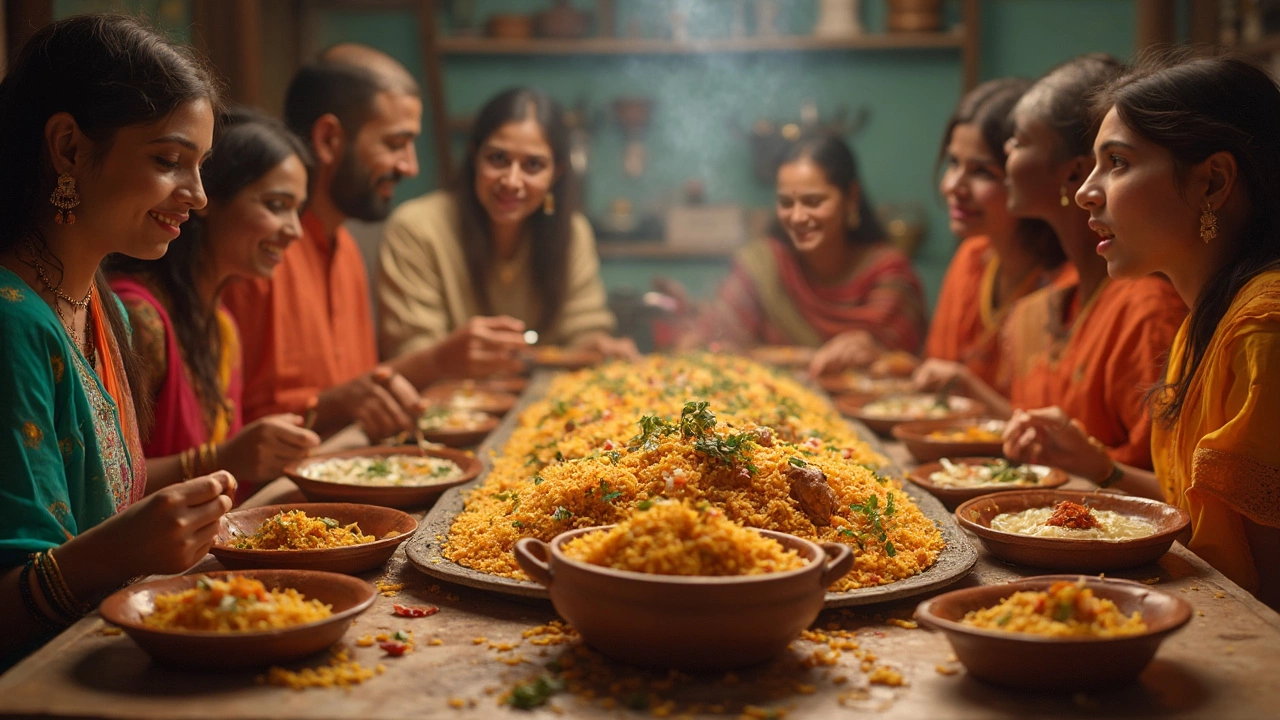Picture this: a platter of biryani steaming with aromas that whisk you away to a bustling kitchen somewhere in Hyderabad or Lucknow. There it lies, with perfectly cooked grains of basmati, tender chunks of meat, and a treasure trove of spices. But what's the right way to enjoy this culinary masterpiece?
First thing's first, biryani lovers: each spoonful should be an artful mix of its layers. Whether you choose to gently blend it or savor the layers separately, make sure every bite offers the full symphony of flavors. Remember, a well-cooked biryani holds its own even when mixed – the grains should remain distinct and the flavors vibrant.
- Understanding Biryani’s Layers
- Mixing vs. Layering
- Enhancing with Accompaniments
- Cultural Traditions and Etiquette
Understanding Biryani’s Layers
Biryani isn’t just tossed together like a salad; it’s built, layer by layer, like a delicious tower of flavors. Each part has its own role in making sure you experience the true essence of this dish.
Rice: The Foundation
The biryani starts with a base of basmati rice. The rice is usually parboiled and spiced with aromatic bay leaves, cloves, and cardamom. When cooked right, it should be fluffy and fragrant, not mushy. The long grains help in keeping each spoonful non-sticky and totally savory.
The Core: Meat or Veggies
This layer is where the magic happens. Whether it’s marinated chicken, tender mutton, or flavorful vegetables for the vegetarians, this layer is cooked with a variety of spices. Think coriander, cumin, ginger, and sometimes a dash of saffron for that golden glow and unique aroma. The key is to allow the ingredients to infuse thoroughly within the meat or veggies, making each piece a burst of flavor.
The Toppings: Garnish Galore
On top, you’ll often find fried onions (those crispy brown delights), nuts like cashews, and herbs such as mint and coriander. Sometimes, hard-boiled eggs add an extra layer of richness. Each topping contributes not only to the look of the dish but also its complex flavor profile.
| Layer | Main Component | Spices |
|---|---|---|
| Base | Basmati Rice | Bay leaves, Cloves, Cardamom |
| Core | Meat/Veggies | Coriander, Cumin, Ginger, Saffron |
| Top | Fried Onions, Nuts | Mint, Coriander |
Each layer has its function, and together they create the magic that is biryani. Understanding and appreciating these layers can make your biryani experience even more rewarding. Next time you dig in, remember: there’s an entire culinary history packed into each bite!
Mixing vs. Layering
When it comes to eating biryani, there's a bit of a friendly debate: should you mix it all up or savor each layer separately? Both methods have their die-hard fans and it's worth trying both to see which side you stand on.
Mixing for Uniformity
Mixing your biryani ensures that all spices and flavors are distributed evenly. When done right, this can mean a more uniform taste in each bite. Some culinary enthusiasts argue that mixing brings out the richness of the dish, ensuring that the spicy meat, saffron-infused rice, and any other bits like fried onions or nuts all contribute to a well-rounded flavor profile.
Here’s a quick guide to mixing:
- Start by breaking apart the mound of rice gently using a fork. Avoid using a spoon to preserve the integrity of each grain.
- Gently fold the rice and meat together, ensuring even distribution without crushing the ingredients.
Layering for Flavors
On the flip side, keeping the biryani in layers allows you to experience each component. The rice, meat, and sides all have their distinct roles. Layering respects the artistry behind each part of the dish. When you serve layered biryani, those who eat can customize their bites – a bit of spicy meat here, some saffron-kissed rice there. It’s like building your own flavor adventure.
| Mixing | Layering |
|---|---|
| Ensures steady flavor in every spoonful. | Allows distinct taste from each component. |
| Perfect for those who love consistency. | Ideal for those who enjoy varied textures and flavors. |
Ultimately, the choice between mixing and layering your biryani lies in how you wish to enjoy your meal. There’s no wrong way, only the way that makes you happiest!

Enhancing with Accompaniments
Pairing the right accompaniments with your biryani can elevate your meal from delicious to unforgettable. It's all about blending flavors and textures that complement the already rich taste of biryani.
In many classic biryani experiences, raita is a must-have. Made with yogurt and cucumbers, this cool and tangy side dish balances the spice and heat of the biryani. You can tweak it to your liking—add mint for extra freshness or boondi for a delightful crunch.
Pickles and Papad
Another perfect partner for your biryani are spicy pickles. A small serving of tangy mango or lime pickle can add a zesty kick to each bite. Crunchy papads, those thin, crispy crackers, are great for adding texture and a savory crunch.
A Sweet Finish
No biryani meal is complete without a subtle sweet touch at the end. Traditional sweets like gulab jamun or a simple saffron-infused phirni can round off the meal nicely. They offer a gentle, sweet contrast to the bold spices of the biryani.
| Accompaniment | Flavor Profile |
|---|---|
| Raita | Cool, Tangy |
| Pickles | Spicy, Tangy |
| Papad | Crispy, Savory |
| Gulab Jamun | Sweet |
These accompaniments don't just add taste but also balance and enhance the overall experience of enjoying biryani. Whether you're a fan of traditional favorites or want to experiment with new combinations, don't skip the opportunity to brighten up your biryani meal with the right sides.
Cultural Traditions and Etiquette
Biryani is not just food; it's a cultural experience that's been passed down through generations. Around the world, particularly in South Asia, eating biryani is about more than satisfying hunger; it’s about celebrating community and tradition.
Biryani is often served at special occasions like weddings, religious festivals, and family gatherings. In many cultures, it's a dish that brings people together, symbolizing warmth and hospitality. Serving it is an art in itself, often done with grandeur, especially in formal settings where it's presented on large communal platters.
Respectful Eating Practices
In cultural contexts, there are certain etiquettes to observe. Traditionally, biryani is eaten with the right hand. It's about feeling the texture of the rice and meat, which many believe enhances the dining experience. Eating with hands may seem unfamiliar to some, but it’s deeply rooted in cultural practices and reflects respect for tradition. If you're invited to a biryani feast, notice how others partake—it’s both a learning and bonding experience.
Accompaniments: The Perfect Pairings
Biryani is often served with cooling side dishes that complement its rich flavors. Common accompaniments include raita, a yogurt-based condiment with cucumber or other veggies, and a simple salad of onions and tomatoes. You might also encounter spicy pickles or crispy papadums as crunchy sides. These additions balance the meal, enhancing the overall flavor profile.
A typical biryani meal might also feature a sweet ending, like a small serving of dessert. This could be anything from a fragrant gulab jamun to a creamy rasmalai, completing the dining experience.
Remember, enjoying biryani is as much about savoring its taste as it is about respecting the traditions that gave us this incredible dish. So, the next time you dig into a plate, think of the stories behind those fragrant layers.
